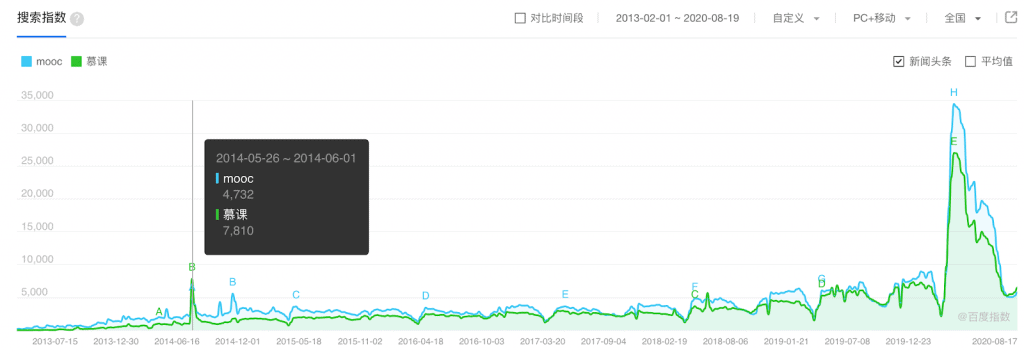The Rise & Fall of Guokr MOOC Academy: China’s Defunct Class Central
The story of the Chinese MOOC aggregator and online learning community.
On the day of its launch back in July 2013, Guokr MOOC Academy (mooc.guokr.com) attracted over 15k learners, making it at the time China’s largest MOOC community. One year later, this number had grown to 500k.
But in mid-August 2018, the website shut down. At the time, it listed 6240 courses from 40+ providers. Learners were allowed to export some of their data, such as notes and certificates.
In this article, we retrace the story of Guokr MOOC Academy.
2012: The Beginnings

Just like Class Central, Guokr MOOC Academy originated from the first MOOC wave. In 2011, three Stanford professors put their courses online, attracting in total over 350k learners. This wave led the following year to the creation of the three main US MOOC platforms: Coursera, edX, and Udacity. The New York Times would go on to declare 2012 the “Year of the MOOC.”
In late 2012, a group called the “MOOC Study Group” on Guokr, an online community launched in 2008 and dedicated to science and technology education, captured Guokr’s attention. The group had been created by an avid MOOC-taker and had attracted over 10k learners in just a few months.
Emboldened by this rapid growth and the MOOC euphoria, in July 2013, Guokr launched its MOOC portal, the Guokr MOOC Academy.
2013 – 2014: Fleshing Out the Portal
Gradually, the Guokr MOOC Academy started aggregating MOOCs from providers such as Coursera, edX, and Udacity, and building features to allow learners to discuss, follow, rate, and review courses, but also share course notes.
In August 2013, Edu-Infinity, a nonprofit MOOC translation organization initiated on Guokr created Chinese subtitles for the course Social Psychology. The following month, the organization joined the Coursera Translation Partners Program. Over the next year, their distributed team of 170 volunteers worldwide subtitled over 90 courses.
Guokr MOOC Academy published a series of interviews with well-known MOOC instructors, including Anant Agarwal (edX founder) and Charles Severance (Programming for Everybody). They also shared resources created by learners, such as course notes.
Three scholarships were launched, in partnership with the United Nations Population Fund (UNFPA), Vank Foundation, and AkzoNobel.
Guokr MOOC Academy received a lot of attention on Chinese media, including from China Central Television: a report broadcasted in May 2014 led to a 200% increase in searches for “MOOC” (or 慕课 in Chinese).

By the end of 2014, Guokr MOOC Academy listed over 2000 courses from 320 institutions and 34 providers. Around 10k reviews and notes were shared by nearly 800k learners, although 70% of them were previous Guokr users. Guokr ended the year with a $20M Series C Round led by TAL Education Group.
2015 – 2016: Growth and Troubles
Guokr MOOC Academy started expanding its team, updating its portal, increasing its course catalog, and tightening its relationship with universities in China.
In early 2015, they began recruiting interns and full-time employees. By the end of the year, they had “50 members including 20 engineers”, according to a Class Central source.
In June 2015, there were over 3000 courses on the platform and over 20k reviews and course notes. They even began offering rewards to incentivize reviewing courses and sharing notes. In partnership with Coursera, they also began hosting Coursera MOOCs directly.
Ties to Coursera
The growth of Guokr MOOC Academy happened in parallel to the growth of Coursera in China. In May 2015, China surged past India as Coursera’s largest overseas market with 1 million users. Around the same time, Guokr MOOC Academy also reached 1 million learners. “There’s a significant overlap between Coursera users in China and Guokr MOOC Academy users”, said Rick Levin, back then CEO of Coursera.
But Coursera’s Chinese market didn’t grow fast enough. In mid-2016, Coursera stopped its operations in China. Their user base only recently reached 3 million learners in China, a number that pales in comparison to their growth in western markets. As China took a backseat to other markets on Coursera’s roadmap, so did Coursera’s Chinese partners, including Guokr MOOC Academy.
Emergence of China’s MOOC Platforms
Meanwhile, China’s domestic MOOC platforms XuetangX and China University MOOC (iCourse) were growing rapidly. XuetangX went from 300k users in October 2014 to 1.3 million users in October 2015 to 5 million users in October 2016. Meanwhile, iCourse grew from 1 million users in September 2014 to 6.2 million in December 2016.
However, Guokr MOOC Academy’s catalog was skewed toward US providers: Coursera and edX accounted for almost half the catalog (respectively, 22% and 21% of all courses) while iCourse and XuetangX accounted for less than a tenth (respectively, 4.7% and 3.6%).
In addition, Coursera, edX, and Udacity stopped providing free certificates while XuetangX and iCourse provided free access and certificates for all courses. Since Guokr MOOC Academy’s catalog emphasized the former providers over the latter, it might have lost some of its appeal.
2017 – 2018: The Downfall
Starting late 2016, Guokr MOOC Academy began showing signs of turmoil and urgency: improper ads began plaguing the user experience and learners started voicing their discontent over the direction the platform was taking.
Compounded by the increasing popularity of China’s local MOOC platforms such as XuetangX, Guokr MOOC Academy’s catalog plateaued. In August 2017, the catalog reached 6240 courses and stopped expanding. A year later, in August 2018, Guokr MOOC Academy shut down.
Tags








R.Yang
There is an important aspect that this essay didn’t mentioned: network connection. Before XuetangX hosted some MOOCs the network is simply a disastor. When XuetangX hosted some course (but of course not all courses) this problem is alleviated, but the choices of course are limited to those with smooth access.